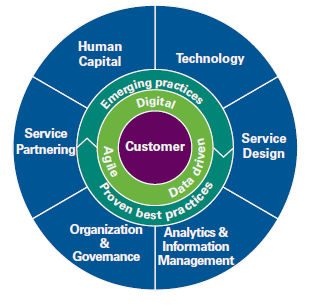By Harry Osle
The digital era has raised the performance bar for HR organizations. Today’s HR organization must strive not just for world-class performance as traditionally measured, but rather, digital world-class performance. Putting the HR stakeholder at the center of the service delivery model guides the overall digital, agile and data-driven enterprise culture. This shift in perspective allows best practices, both proven and emerging, to power the transfer of momentum from the outer ring of six interconnected service delivery capabilities: technology, service design, analytics and information management, organization and governance, service partnering, and human capital.
World-class HR organizations are those that achieve top-quartile performance in both efficiency and effectiveness across an array of weighted metrics in The Hackett Group’s comprehensive HR benchmark. Digital world class is The Hackett Group’s estimate of the additional benefit that world-class HR organizations can derive from full technology enablement of execution of HR work and optimization of the HR technology landscape.
The Hackett Group Digital HR Service Delivery Model

Technology
The convergence of cloud-based infrastructure and applications, virtual business and technology networks, and smart automation is creating exciting new opportunities for HR organizations, enabling them to apply digital technologies to transform service delivery.
Electronically enabled processes reduce errors and make information easier to access without the need for assistance by HR staff. Increasingly, digital technology is becoming the platform for a whole new class of services, such as virtual assistants to answer employee queries or artificial intelligence that nudges managers to reach out to prized employees before they become flight risks.
Service Design
With widespread talent shortages and retention difficulties, the concept of employee experience is being widely embraced as a key to attracting and keeping high caliber talent. HR organizations now recognize the importance of a good employee experience and their role in ensuring it. While many HR organizations primarily view employee experience through the lens of their interactions with HR (and mainly its technology infrastructure), top performers are almost three times more likely to incorporate touchpoints across the entire enterprise in their employee experience strategies.
Analytics and Information Management
World-class HR organizations are concerned not just with their own performance but with how they can enable the success of the enterprise. For example, they use talent analytics to translate business strategy into its future implications for managing talent, apply analytics to illuminate and eliminate obstacles in the road ahead. This data is also used by the business to prioritize and fund improvements aimed at attraction and retention of talent to fill critical roles.
Organization and Governance
Many HR organizations devote excessive amounts of attention and resources to transactional activities, to the detriment of analytics, measurement and working with organization leaders on devising talent strategies that bolster business results.
To reduce time spent on routine work, HR must make its structure and processes more efficient and effective. A formal service delivery model clarifies roles and responsibilities and matches the capabilities, cost and location of resources (e.g., global business service unit, center of excellence, corporate) with the type of work performed.
Service Partnering
World-class HR organizations utilize the capabilities of external service providers to greater effect than typical HR groups. For example, while they allocate nearly the same percentage of their budget to outsourcing, they spend less to manage those relationships. More important, they can leverage third-party relationships to reduce overall process costs and internal staff levels (or staff up quickly in response to changes in demand).
Human Capital
World-class HR organizations employ a different mix of staff than the average HR organization, with more professionals and fewer managers. This holds true for each major HR process category – planning and strategy, employee lifecycle and transactional/administrative. This suggests the presence of staff with the ability to do more advanced work.
The higher overall quality of world-class HR staff is evidenced by greater numbers who have effective strategic thinking and analysis skills, goals aligned to company strategy and outstanding leadership abilities. The qualitative attributes of staff are a key contributing factor to why world-class HR organizations are so effective.
Jumpstarting and Accelerating HR Digital Transformation
There are many steps that HR organizations can take to improve their performance and value, whether in the beginning or later stages of transformation. The Hackett Group’s experience working with thousands of organizations underscores the measurable cost and productivity benefits of taking these steps:
HR organizations just beginning their digital transformation
- Measure baseline efficiency, effectiveness and customer experience: Benchmark HR to provide a foundation for assessing performance, evaluating capabilities and identifying improvement opportunities.
- Use a portfolio approach to documenting HR projects: Evaluate initiatives based on their alignment with business and HR objectives, and their strategic and operational impact.
- Assess staffing levels and skills mix: Make sure the number and capabilities of staff correspond with documented stakeholder needs.
- Reduce complexity: Simplify, standardize and streamline programs and processes for greater consistency and performance.
- Deploy technology to improve process quality and cycle time: Digital technologies such as cloud-based systems and RPA can be applied to upgrade transactional and administrative performance.
- Adopt a digital service delivery model that aligns task complexity with available technology and skills: Align people and skills based on business priorities, value and cost considerations.
HR organizations that are well down the road toward digital transformation
- Review KPIs and take action where improvement is needed: Metrics should gauge what drives performance and how successful HR is at meeting its strategic goals. Work with business leaders to develop initiatives aimed at improving these performance barometers.
- Put customers at the center of service design: Design service delivery for different workforce segments and levels of management. Apply methods such as focus groups, design committees, user personas, customer journey mapping and iterative prototyping.
- Use digital technology to increase productivity and improve the customer experience: Provide information and tools that increase the productivity of HR staff and the overall workforce. Use a “mobile first” principle to enforce simplicity of design. Accelerate the deployment of smart automation such as chatbots to handle routine inquiries and transactions.
- Build analytics capabilities: To develop better insights and decisions, assign dedicated analytics resources within HR. Establish data management governance and processes to provide consistent, usable and meaningful data for analytics.
- Develop HR’s digital skills: Redesign HR roles and career paths to incorporate digital skills requirements: technical (e.g. analytics and modeling), behavioral (e.g., agility and change orientation) and business (e.g., data savviness). Train HR staff, especially those in business partner roles, to solve problems using data and to package analytical findings into business-relevant stories and recommendations.
- Increase HR’s business acumen: Recruit from other parts of the company and HR/business hybrid talent pools. Assign staff to cross-functional teams to learn about the operations of different parts of the organization.
- Build capabilities that can improve business performance, such as leadership, innovation and agility: For example, implement initiatives aimed at developing innovation skills companywide, such as creativity among the general workforce and innovation-nurturing among managers.
Regardless of where they are in their transformations, those HR organizations reaping the most benefits of digital technology have a clear vision how digital technology enables their HR strategy and operating model and a detailed roadmap of the steps needed to successfully implement the change.

Harry Osle, Principal in Charge
Global Human Resources Practice Leader
The Hackett Group
Mr. Osle has more than 20 years of experience in human resources and transformation. At The Hackett Group, he advises clients on leveraging HR best practices, organizational alignment, optimization and automation, project management and needs analysis. He is an expert in HR strategy development, service delivery model design, benchmarking, and HCM selection and implementation.
